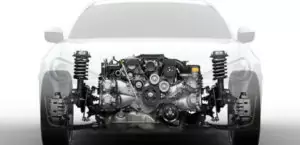The 1.5-liter Great Wall GW4G15 engine has been produced at the Chinese plant since 2008 and is installed on such popular models as the Hover M2, M4 or the similar Haval H1. This power unit was essentially a licensed copy of the Japanese Toyota 1NZ-FE engine.
Clones of Toyota engines: GW4G15, GW4G15B, GW4G15K, GW491QE.
Specifications
| Production years | since 2008 |
| Displacement, cc | 1497 |
| Fuel system | distributed injection |
| Power output, hp | 95 – 105 |
| Torque output, Nm | 132 – 138 |
| Cylinder block | aluminum R4 |
| Block head | aluminum 16v |
| Cylinder bore, mm | 75 |
| Piston stroke, mm | 84.7 |
| Compression ratio | 10.5 |
| Features | DOHC |
| Hydraulic lifters | no |
| Timing drive | chain |
| Phase regulator | VVTi at the intake |
| Turbocharging | no |
| Recommended engine oil | 5W-30 |
| Engine oil capacity, liter | 3.5 |
| Fuel type | petrol |
| Euro standards | EURO 4 |
| Fuel consumption, L/100 km (for Great Wall Hover M2 2014) — city — highway — combined |
8.8 6.9 7.4 |
| Engine lifespan, km | ~250 000 |
| Weight, kg | 115 |
The engine was installed on:
- Great Wall Coolbear in 2009 – 2015;
- Great Wall Florid in 2008 – 2013;
- Great Wall Hover M2 in 2011 – 2015;
- Great Wall Hover M4 in 2012 – 2016;
- Great Wall Voleex C10 in 2010 – 2014;
- Great Wall Voleex C30 in 2010 – 2016;
- Haval H1 I in 2012 – 2014; H1 II since 2014.
Disadvantages of the Great Wall GW4G15 engine
- The most famous problem of engines of this family is oil consumption;
- The main reason is the poor operation of the crankcase ventilation or the occurrence of rings;
- Closer to 100,000 km, it is often necessary to replace the timing chain and often with a phase shifter;
- The weak points of the unit include the ignition system, turbine valve and engine mounts;
- Valve clearances require adjustment by selecting tappets every 90,000 km.





